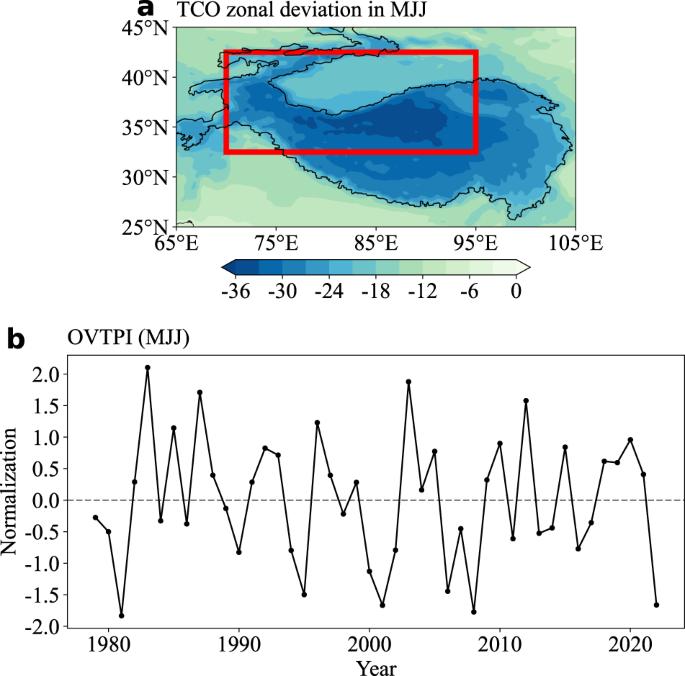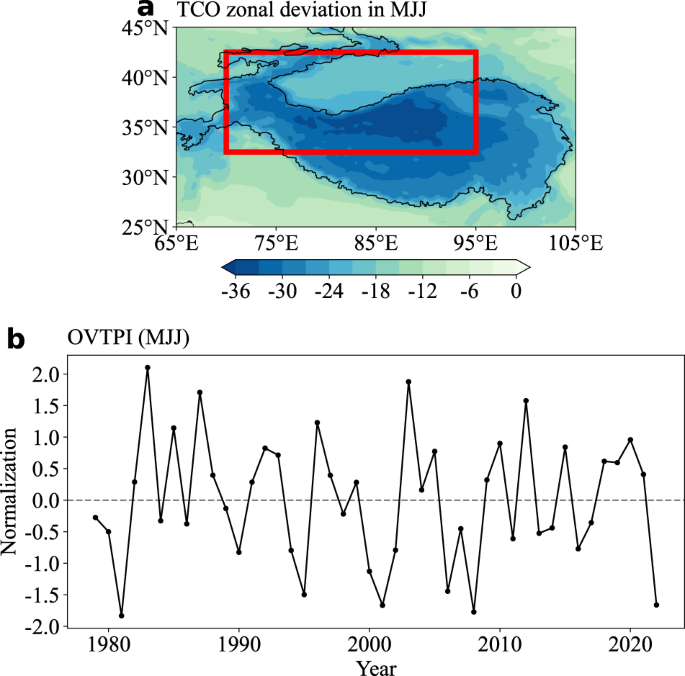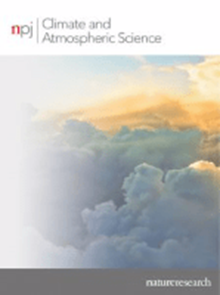青藏高原上空的臭氧谷对东亚夏季降水的影响有多大?
IF 8.5
1区 地球科学
Q1 METEOROLOGY & ATMOSPHERIC SCIENCES
引用次数: 0
摘要
青藏高原臭氧谷在过去几十年中经历了显著的年际变化。先前的研究主要关注OVTP的起源,而不是其对气候的影响。这项研究表明,OVTP在其旺季(5月至7月)解释了东亚高达15%的夏季降水变化。结果表明,青藏高原(TP)的地表温度(Ts)异常是OVTP与东亚降水之间的联系。通过陆地大气的正反馈,放大了TP上空的Ts异常。由于陆地记忆效应,异常Ts模式持续到夏季(6-8月),并通过调节局部环流影响东亚降水。利用指定化学版的全大气群落气候模型验证了MJJ OVTP导致Ts显著高于TP,并在夏季引发以江淮流域为中心的异常反气旋。因此,长江流域出现负降水异常,而中国南方出现正降水异常。线性斜压模型进一步证明了热带风暴上空的非绝热加热是MJJ OVTP与东亚夏季降水模式之间的联系。我们对耦合模型相互比较项目第6阶段模型的分析表明,要更准确地预测东亚降水量,需要更好地理解OVTP和TP Ts之间的关系。本文章由计算机程序翻译,如有差异,请以英文原文为准。


To what extent can the ozone valley over the Tibetan Plateau influence the East Asian summer precipitation?
The ozone valley over the Tibetan Plateau (OVTP) has experienced significant interannual variations during the past decades. Previous studies have primarily focused on the origins of OVTP rather than its climate impact. This study reveals that OVTP during its peak season (May–July) explains up to 15% of the summer precipitation variability in East Asia. The results suggest that the surface temperature (Ts) anomaly over the Tibetan Plateau (TP) acts as a link between OVTP and East Asian precipitation. Through the positive land-atmosphere feedback, the Ts anomaly over the TP is amplified. The anomalous Ts pattern persists into summer (June–August) due to the land memory effect and impacts the East Asian precipitation by modulating the local circulation. The Specified-Chemistry version of the Whole Atmosphere Community Climate Model is employed to validate that MJJ OVTP results in a substantial increase of Ts over TP and induces an anomalous anti-cyclone centered over the Yangtze-Huaihe River Basin during summer. Consequently, negative precipitation anomalies are observed in the Yangtze River Basin, while positive precipitation anomalies occur in Southern China. The linear baroclinic model further demonstrates that the diabatic heating over the TP serves as the link between MJJ OVTP and East Asian summer precipitation patterns. Our analysis of Coupled Model Intercomparison Project Phase 6 models reveals that a more accurate prediction of East Asian precipitation requires an improved understanding of the relationship between OVTP and TP Ts.
求助全文
通过发布文献求助,成功后即可免费获取论文全文。
去求助
来源期刊

npj Climate and Atmospheric Science
Earth and Planetary Sciences-Atmospheric Science
CiteScore
8.80
自引率
3.30%
发文量
87
审稿时长
21 weeks
期刊介绍:
npj Climate and Atmospheric Science is an open-access journal encompassing the relevant physical, chemical, and biological aspects of atmospheric and climate science. The journal places particular emphasis on regional studies that unveil new insights into specific localities, including examinations of local atmospheric composition, such as aerosols.
The range of topics covered by the journal includes climate dynamics, climate variability, weather and climate prediction, climate change, ocean dynamics, weather extremes, air pollution, atmospheric chemistry (including aerosols), the hydrological cycle, and atmosphere–ocean and atmosphere–land interactions. The journal welcomes studies employing a diverse array of methods, including numerical and statistical modeling, the development and application of in situ observational techniques, remote sensing, and the development or evaluation of new reanalyses.
 求助内容:
求助内容: 应助结果提醒方式:
应助结果提醒方式:


